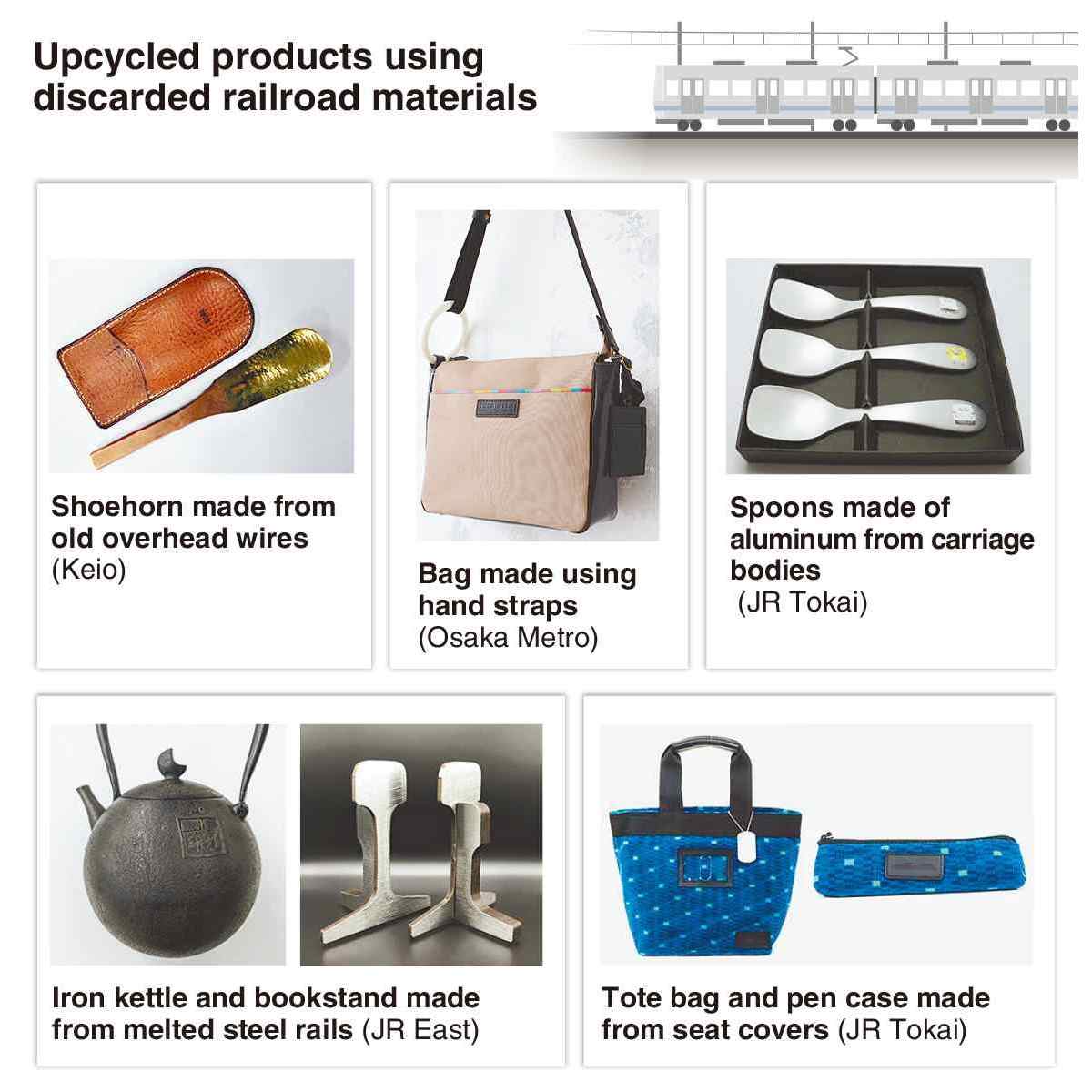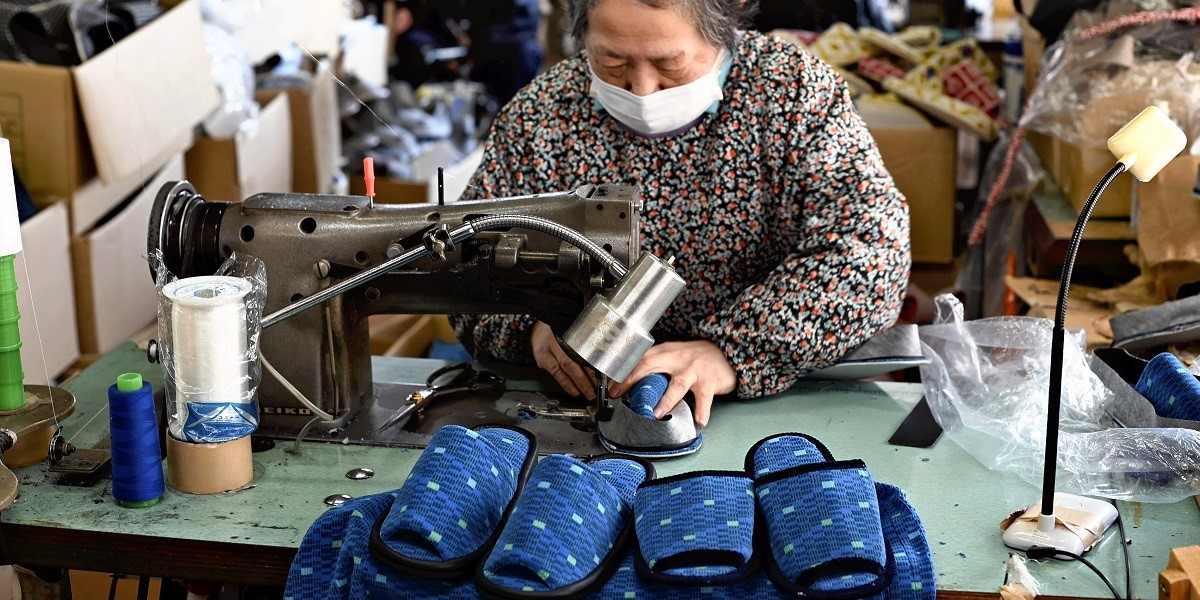
15:45 JST, May 1, 2023
Efforts to launch upcycling and recycling initiatives in the railroad industry are spawning new products from discarded items that would otherwise be thrown away.
From slippers created by sewing together seat covers, to shoehorns fashioned from worn overhead wires and iron kettles made from melted-down steel rails, many of these practical everyday items are even helping to attract new railroad fans.
‘N700 Series’ slippers
In early February in Kahoku, Yamagata Prefecture, one of the nation’s leading slipper production centers, seven veteran craftspeople were skillfully sewing pairs of specialty slippers at the factory of venerable Kawauchi Slipper, which was founded in 1955.
The material used for the slippers came from seat covers used on N700 Series Tokaido Shinkansen bullet trains. They are being made to order for Central Japan Railway Co. (JR Tokai), which is trying to make effective use of the 1,200 kilograms of seat covers it discards each month.
“It’s not easy to mass-produce the slippers, but I have absolute confidence in the quality. We are happy to be able to contribute to the effort to reduce waste materials,” said Kazuko Okada, a craftsperson with more than 20 years of experience.
Kawauchi Slipper began producing the Shinkansen slippers at the request of Choichiro Tsuchiya, 72, a recycler in Yamagata.
Tsuchiya, who had been contracted to clean seat covers more than 10 years ago at East Japan Railway Co.’s (JR East’s) Shinkansen General Rolling Stock Center in Rifu, Miyagi Prefecture, saw a large number being thrown away each time they were reupholstered. Thinking that it was a waste to throw away such high-quality fabric, he suggested that the company commercialize the product.
At that time, the concept of upcycling was not yet widespread. His idea was rejected by the company, which said it was unthinkable to sell discarded items. It took two to three years to convince them to change their minds. Now, in addition to slippers, JR Tokai sells pen cases, coin purses and cushions.
“The customers are very pleased with the products. I had an unerring eye,” Tsuchiya said.

Slippers are made by stitching together seat covers from Tokaido Shinkansen bullet trains with a sewing machine in Kahoku, Yamagata Prefecture.
Environmentally friendly
With the recent spread of the notion of creating a “circular economy” that balances economic growth with a reduced environmental impact, rail companies have begun to focus on the development of upcycled products.
In November last year, Keio Corp. started fashioning shoehorns from worn overhead copper wires. They come with a leather case engraved with “KO27,” the designation of Keio Line’s Seiseki Sakuragaoka Station in Tama, Tokyo, the closest station to the company’s headquarters.
The shoehorns have been adopted as a return gift for the Tama city government’s furusato nozei, a tax-deductible donation program. Those who donate ¥140,000 can obtain the shoehorn as a gift in return for the donation.
After JR East cut up rails that had been laid on the platform of the Yokosuka Line at Shinagawa Station in Tokyo, they turned them into bookshelves last October.
Since February this year, JR Tokai has also been reusing aluminum from Tokaido Shinkansen carriages to make spoons and tie pins for sale.
Osaka Metro Co. has also been commercializing products since spring last year that carry a label saying “scrapped train reconditioning project.” The products include bags made from subway car hand straps and gangway connections, and tables made from sliding doors.
“We have come up with products that will encourage people to continue riding the subway with a special sense of attachment,” an Osaka Metro official said.
Cultivating new fans
Railroad companies are known from time to time to sell destination signs and front nameplates from trains, as well as the seats of discontinued trains, which prove wildly popular among railway enthusiasts.
Meanwhile, the appearance of practical upcycled products has attracted brand-new fans.
Last December, at the initiative of a young employee at JR East’s Morioka branch office, the company began selling Nambu tekki iron kettles made of melted-down Kamaishi Line rails.
Nambu Tekki is the name of traditional Iwate cast ironware. Handmade by craftsmen in a workshop in Iwate Prefecture, the kettles cost between ¥89,000 and ¥330,000 each. Despite the high price, 10 had been ordered as of April.
Yasuhiro Nishibe, 48, a building contractor in Iida, Nagano Prefecture, ordered two kettles — one for himself and one as a gift. He said he was not interested in trains, but was drawn to the story of how used rails are transformed into kettles that will last a lifetime.
“The idea of making an iron kettle from a steel rail is interesting, and it will be a topic of conversation when I give one as a gift,” he said.
"Society" POPULAR ARTICLE
-

M4.9 Earthquake Hits Tokyo, Neighboring Prefectures
-

M7.5 Earthquake Hits Northern Japan; Tsunami Waves Observed in Hokkaido, Aomori and Iwate Prefectures
-

Israeli Tourists Refused Accommodation at Hotel in Japan’s Nagano Pref., Prompting Protest by Israeli Embassy and Probe by Prefecture
-

Tsukiji Market Urges Tourists to Avoid Visiting in Year-End
-

M5.7 Earthquake Hits Japan’s Kumamoto Pref., Measuring Upper 5 Intensity, No Tsunami Expected
JN ACCESS RANKING
-

Keidanren Chairman Yoshinobu Tsutsui Visits Kashiwazaki-Kariwa Nuclear Power Plant; Inspects New Emergency Safety System
-

Imports of Rare Earths from China Facing Delays, May Be Caused by Deterioration of Japan-China Relations
-

University of Tokyo Professor Discusses Japanese Economic Security in Interview Ahead of Forum
-

Japan Pulls out of Vietnam Nuclear Project, Complicating Hanoi’s Power Plans
-

Govt Aims to Expand NISA Program Lineup, Abolish Age Restriction

















